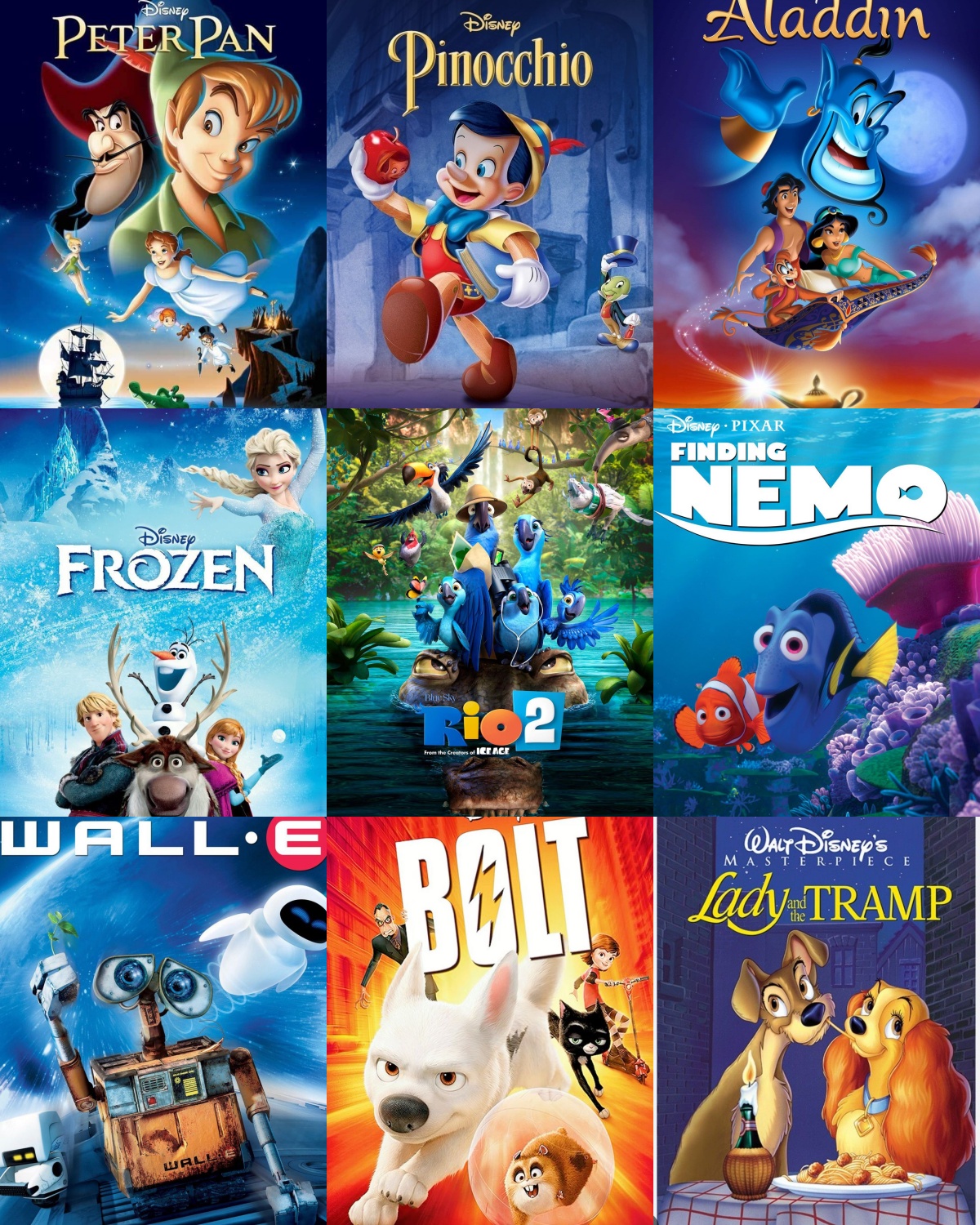Animation Across Decades: Celebrating the Best Films in History

Related Movies:
Related Movies:
Related Movies:
Related Movies:
Related Movies:
Related Movies:
Related Movies:
Peter Pan (1953):
Peter Pan (1953) is a timeless Disney classic that captures the magic and wonder of childhood imagination, adventure, and the belief in endless possibilities. Based on J.M. Barrie’s beloved play and novel, the film follows the story of Peter Pan, a mischievous and adventurous boy who never grows up. He flies to London one night and takes Wendy Darling and her brothers, John and Michael, on a magical journey to Neverland, a fantastical place filled with pirates, fairies, and unforgettable characters.
The heart of Peter Pan lies in its celebration of childhood and the sense of freedom and adventure that comes with it. Peter, who is both a daring hero and a free spirit, represents the idea of refusing to be bound by the rules of the adult world. Wendy, on the other hand, represents the nurturing side of family and growth, providing a balance to Peter’s carefree spirit. The film explores themes of staying true to one’s imagination, the importance of family, and the bittersweet nature of growing up.
The animation in Peter Pan is vibrant and filled with energy, capturing the fantastical nature of Neverland and its colorful characters. From the sparkling pixie dust that allows Peter to fly to the lush jungle landscapes of Neverland, the visuals are both beautiful and enchanting. The contrast between the ordinary world of London and the magical world of Neverland heightens the sense of adventure and wonder as the characters move between these two realms.
The voice cast brings the characters to life with warmth and charm. Bobby Driscoll’s portrayal of Peter Pan gives the character a mischievous yet endearing quality, perfectly capturing his playful nature. Kathryn Beaumont’s Wendy is gentle and caring, providing the heart of the story. The supporting characters, such as the lovable Tinker Bell (voiced by Margaret Kerry) and the villainous Captain Hook (voiced by Hans Conried), add further depth and humor to the narrative. Captain Hook, with his exaggerated personality and constant rivalry with Peter, is a memorable and entertaining villain who provides much of the film’s conflict and tension.
The film’s iconic soundtrack, including songs like “You Can Fly! You Can Fly! You Can Fly!” and “Following the Leader,” is joyful and filled with whimsy, perfectly complementing the adventurous spirit of the story. The music enhances the emotional highs and playful moments, leaving audiences humming along to the infectious tunes.
Peter Pan is more than just a children’s film — it’s a celebration of the innocence of youth and the power of imagination. The story’s themes of adventure, growth, and family have made it a beloved classic for generations. It captures the magic of flying to a world where anything is possible, and reminds us all of the importance of holding on to the childlike wonder within us.
Peter Pan (1953) is a beautifully animated, heartwarming, and unforgettable film that continues to resonate with audiences young and old. With its endearing characters, timeless music, and magical world, it remains a quintessential Disney classic that will continue to inspire dreams of flight and adventure for years to come.
Pinocchio (1940):
Pinocchio (1940) is a Disney masterpiece that combines enchanting animation, timeless storytelling, and valuable life lessons into a film that continues to captivate audiences more than eight decades after its release. Based on Carlo Collodi’s classic Italian novel, the film tells the story of a wooden puppet named Pinocchio, who comes to life and embarks on a journey to become a real boy. Guided by his father, the kindly woodcarver Geppetto, Pinocchio must learn important lessons about honesty, bravery, and responsibility.
At its heart, Pinocchio is a story about growing up and the moral choices we face as we move through life. The film explores the importance of honesty and integrity, with Pinocchio’s constant struggle to resist temptation and tell the truth providing the emotional backbone of the story. The classic catchphrase “A lie keeps growing and growing, until it’s as plain as the nose on your face” captures one of the film’s central themes: the consequences of dishonesty and the importance of making the right choices.
The animation in Pinocchio is groundbreaking for its time, with lush, detailed backgrounds, fluid character movements, and vibrant color that bring the magical world of Pinocchio to life. The character design is iconic, from Pinocchio’s expressive face to the whimsical creatures and characters he encounters along the way, like Jiminy Cricket (voiced by Cliff Edwards), who serves as Pinocchio’s conscience. The film’s use of animation to express emotion and tell the story visually is still admired today, and the heart-pounding scenes, such as when Pinocchio and Geppetto are trapped inside the whale Monstro, showcase the suspense and dramatic tension that was groundbreaking in animated films at the time.
The voice cast brings warmth and charm to the film. Dickie Jones’s portrayal of Pinocchio captures the character’s innocence, curiosity, and vulnerability, making him a relatable and empathetic protagonist. Cliff Edwards’s voice work as Jiminy Cricket is a standout, with his mix of wisdom and humor adding both levity and depth to the film. The villainous characters, such as the manipulative Honest John and the ruthless Stromboli, provide both conflict and danger, serving as foils to Pinocchio’s growth.
The soundtrack is unforgettable, with songs like “When You Wish Upon a Star” becoming an enduring Disney anthem that embodies the hope, dreams, and magic that define the film. The music reinforces the emotional moments, from the joy and wonder of Pinocchio’s creation to the sorrow and longing he feels when separated from Geppetto.
Pinocchio (1940) is not just a film for children; it is a timeless classic that resonates with viewers of all ages. It addresses universal themes of responsibility, family, and self-discovery, making it as relevant today as it was when it was first released. The combination of captivating animation, memorable characters, and important moral lessons make Pinocchio a Disney film that continues to inspire and entertain.
With its emotional depth, beautiful animation, and unforgettable songs, Pinocchio stands as one of Disney’s greatest achievements, reminding us that the journey to becoming our true selves is filled with challenges, but that with honesty and courage, we can achieve our dreams.
Aladdin (1992) – Animated Classic Review
“Aladdin,” Disney’s 1992 animated film, is a magical journey through the streets of Agrabah, following the adventures of a “diamond in the rough” street rat, Aladdin, and his loyal companions, a mischievous monkey named Abu and the magical flying carpet. When Aladdin stumbles upon a magical lamp and releases the flamboyant and comedic Genie, played by Robin Williams in an unforgettable performance, his life changes forever.
The film is an exciting blend of romance, adventure, and comedy, with Aladdin’s desire to win the heart of Princess Jasmine driving the story forward. Alongside its vibrant animation, the movie explores themes of identity, friendship, and staying true to oneself.
The supporting characters are equally memorable, with Jasmine breaking traditional princess stereotypes and the hilarious yet sinister villain, Jafar, adding an extra layer of tension. Musically, “Aladdin” boasts some of Disney’s most iconic songs, including “A Whole New World” and “Friend Like Me,” which have become classics over time.
Aladdin’s charm lies in its perfect balance of humor, heart, and spectacle, while also offering a deeper message about self-worth and authenticity. Robin Williams’ unforgettable voice performance as the Genie is a standout, turning the character into one of the most beloved animated figures in cinematic history.
Frozen (2013) – Animated Fantasy Adventure Review
Frozen, Disney’s 2013 animated phenomenon, takes audiences to the icy kingdom of Arendelle, where two royal sisters, Elsa and Anna, share a bond that is tested by a magical curse. Elsa, the older sister, possesses the power to control ice and snow, a gift that she struggles to keep hidden out of fear of hurting others. When her powers are unintentionally revealed, she flees to the mountains, leaving Arendelle in an eternal winter. It’s up to Anna, her fearless younger sister, to embark on a daring adventure to find Elsa and bring her back, aided by a quirky ice harvester named Kristoff, his loyal reindeer Sven, and an adorably naive snowman named Olaf.
The film’s heart is its exploration of sisterhood, love, and self-acceptance. Elsa’s internal struggle to control her powers and her fear of being unloved because of them creates a compelling emotional narrative. The strong bond between Elsa and Anna serves as the heart of the story, offering a refreshing twist on the typical “true love” trope by showcasing the power of familial love.
Visually, Frozen is a masterpiece, with stunning animation that brings the frozen landscapes and characters to life. The snow and ice effects, especially Elsa’s magical creations, are breathtaking and add to the film’s wonder.
Musically, Frozen is iconic, featuring the Oscar-winning song “Let It Go,” performed by Idina Menzel as Elsa. The song became a worldwide hit, and its empowering message resonated deeply with audiences. Other memorable tracks, like “Do You Want to Build a Snowman?” and “For the First Time in Forever,” further enhance the movie’s emotional impact and fun energy.
While Frozen is known for its family-friendly appeal, its universal themes of embracing who you are and the power of love make it a standout in Disney’s modern animated library.
Rio 2 (2014) – Animated Musical Sequel Review
Rio 2 is the vibrant, musical sequel to the 2011 hit Rio. The film picks up where the first one left off, following Blu (voiced by Jesse Eisenberg) and Jewel (voiced by Anne Hathaway) as they settle into family life in Rio de Janeiro. Blu and Jewel, now with three children, are living in the bustling city, but their peaceful life is disrupted when Jewel learns that there may be other Spix’s macaws like her in the Amazon rainforest. Determined to find her roots, she convinces Blu to venture deep into the jungle, where they encounter new challenges, characters, and colorful adventures.
The film continues the original’s energetic, upbeat tone, with plenty of vibrant visuals, exciting action sequences, and lively musical numbers. The lush, tropical setting of the Amazon rainforest adds to the beauty of the animation, with stunning landscapes and intricate details that make the jungle come to life. The movie’s visual appeal is a significant strength, as the bright, saturated colors of Rio de Janeiro blend perfectly with the rich greens and blues of the Amazon.
Blu and Jewel’s relationship is tested as they face different challenges, highlighting themes of family, change, and identity. Blu, who was once an urban bird, struggles with the wild environment of the jungle, while Jewel embraces her roots. Their dynamic offers both humor and heart, as Blu’s neurotic, cautious nature contrasts with Jewel’s confident and adventurous spirit.
The voice cast, including the return of legends like Will.i.am, Jemaine Clement, and Tracy Morgan, injects the film with humor and charm. New characters, like the mischievous and suave Nigel the cockatoo (Clement), add an additional layer of fun to the adventure.
The film’s soundtrack continues the franchise’s tradition of lively, toe-tapping music. Songs like “What is Love?” and “I Will Survive” fill the film with infectious energy, keeping the audience engaged and entertained. The music enhances the film’s festive atmosphere and celebrates its themes of freedom, love, and discovering one’s place in the world.
While Rio 2 might not match the charm and originality of its predecessor, it still delivers a solid and enjoyable family film filled with humor, heartfelt moments, and beautiful visuals.
Finding Nemo (2003) – Animated Adventure Review
Finding Nemo is a heartwarming and visually stunning Pixar classic that continues to resonate with audiences of all ages. Directed by Andrew Stanton, the film follows Marlin, a clownfish, on a daring journey across the vast ocean to find his son, Nemo, who has been captured by a diver and placed in a fish tank in a dentist’s office. Marlin, with the help of the forgetful yet optimistic Dory, embarks on a quest filled with both comedic moments and touching emotions.
The film’s central theme revolves around love, courage, and overcoming fear. Marlin’s relentless determination to rescue his son, despite the dangers that lie ahead, forms the heart of the story. Alongside him, Dory’s quirky personality brings much-needed humor and warmth to the adventure, balancing out Marlin’s more anxious and protective nature.
Visually, Finding Nemo is a masterpiece. The underwater world is brought to life with breathtaking animation, from the colorful coral reefs to the vast, open waters. The attention to detail in the ocean’s creatures and landscapes is extraordinary, making the setting feel both magical and realistic. Pixar’s technical prowess shines through in every scene, with the water and fish movements looking stunningly lifelike.
The voice cast, led by Albert Brooks (Marlin) and Ellen DeGeneres (Dory), delivers standout performances that bring the characters to life. DeGeneres’ portrayal of Dory is particularly beloved, with her cheerful yet slightly forgetful nature adding an extra layer of humor to the film. The supporting characters, such as the quirky sea turtles and the helpful pelican, also add charm and fun to the narrative.
The emotional depth of Finding Nemo is what truly sets it apart. The bond between Marlin and Nemo, as well as the lessons learned about trust, letting go, and the power of love, resonate deeply. The film touches on universal themes of parental love, the importance of overcoming fears, and the value of friendship.
The film’s score, composed by Thomas Newman, complements the movie’s tone perfectly, with gentle, calming melodies that enhance the underwater setting and emotional moments.
WALL-E (2008) – Animated Sci-Fi Drama Review
WALL-E, directed by Andrew Stanton, is a breathtaking and emotionally resonant film that blends stunning animation, social commentary, and a deeply moving love story. Set in a distant future where Earth has been abandoned by humans due to overwhelming pollution and waste, the story centers around WALL-E (short for Waste Allocation Load Lifter: Earth-Class), a small garbage-compacting robot who is left behind to clean up the planet. Over the years, WALL-E has developed a personality, spending his days collecting interesting items and longing for companionship. His solitary existence is interrupted when a sleek, high-tech robot named EVE arrives on Earth in search of a plant that signifies life’s potential return.
At its core, WALL-E is a love story, not only between WALL-E and EVE but also between humanity and its planet. The film showcases the destructive consequences of overconsumption and environmental neglect, using a minimalist dialogue approach, especially in the first act, to make its message even more poignant. Through WALL-E’s small actions and devotion to EVE, the film poignantly explores themes of loneliness, love, and the need for change in how humanity interacts with the environment.
Visually, WALL-E is a masterpiece. The desolate, lifeless Earth is beautifully depicted with intricate details of garbage piles, rusted buildings, and forgotten remnants of humanity’s consumer-driven culture. As WALL-E explores this abandoned world, the art direction immerses the audience in a melancholic yet hopeful atmosphere. In stark contrast, the futuristic spaceship, Axiom, is a stark visual representation of consumerism gone to extremes, with its sterile, technologically driven environment.
The character design of WALL-E is both simple and expressive. Despite being a robot with no human face, WALL-E’s eyes and subtle movements convey so much emotion, allowing the audience to empathize deeply with him. EVE, on the other hand, represents modernity and hope, with her sleek design and more advanced technology.
The lack of dialogue in much of the film doesn’t detract from its emotional depth. WALL-E’s actions, expressions, and the brilliant use of music and sound convey the story’s themes with extraordinary effectiveness. The film also cleverly balances humor and depth, making it suitable for both children and adults. The score, composed by Thomas Newman, complements the emotional tone beautifully, adding layers of warmth, nostalgia, and hope.
The film’s social message about environmental preservation, consumerism, and the future of humanity is subtly woven into the narrative, making it one of the most thought-provoking animated films ever made. It is not just a futuristic adventure but a reflection on the importance of love, care, and responsibility for the planet.
Bolt (2008) – Animated Adventure Comedy Review
Bolt, directed by Chris Williams and Byron Howard, is a charming and heartwarming animated film from Disney that combines action, humor, and heartfelt moments. The story follows Bolt (voiced by John Travolta), a dog who stars in a fictional TV show where he has superpowers. Believing that his powers are real, Bolt embarks on a journey to rescue his beloved owner, Penny (voiced by Miley Cyrus), after she is kidnapped in the fictional world of his show. Along the way, Bolt encounters a street-smart alley cat named Mittens (voiced by Susie Essman) and a hamster named Rhino (voiced by Mark Walton), who is obsessed with Bolt’s on-screen persona.
The central theme of Bolt is about self-discovery and understanding one’s true worth. Bolt starts the film believing in his superpowers, only to realize that they are mere illusions. His journey across the country, alongside his new friends, is a quest not only to find Penny but also to learn that he is valuable for who he truly is, not for the powers he believes he has. The film explores the bonds of friendship and the power of believing in yourself, resonating deeply with viewers of all ages.
The animation in Bolt is vibrant and dynamic, effectively capturing the excitement of Bolt’s action-packed world and the contrasting quieter moments of introspection and growth. The scenes in the real world, where Bolt is separated from the TV set and must navigate through unfamiliar terrain, are beautifully crafted and full of heart. The character designs, especially the lovable, animated dog Bolt and his companions, are both endearing and full of personality.
The voice performances are another highlight, with John Travolta delivering a humorous yet emotionally grounded performance as Bolt. Miley Cyrus brings a relatable, caring side to Penny, while Susie Essman’s voice work as the sarcastic yet ultimately caring Mittens adds much-needed humor and depth. Mark Walton’s portrayal of the overly enthusiastic hamster Rhino provides comic relief, offering plenty of laughs with his obsessive, larger-than-life energy.
The soundtrack, which includes the energetic and heartwarming song “I Thought I Lost You” by Miley Cyrus and John Travolta, enhances the film’s emotional beats and reinforces its themes of love, loyalty, and finding one’s true self.
Though Bolt is a fun adventure for children, its themes about self-worth and the journey to find one’s identity make it appealing for adults as well. The film blends action, humor, and emotion seamlessly, delivering a heartwarming story with memorable characters.
Lady and the Tramp (1955) – Animated Classic Review
Lady and the Tramp, Disney’s beloved 1955 animated feature, is a heartwarming tale of love, adventure, and the joy of companionship. Set in a charming turn-of-the-century town, the film follows Lady, a well-mannered cocker spaniel from an affluent home, and Tramp, a street-smart mutt who roams freely through the streets. When Lady’s life is disrupted by the arrival of a new baby in her household, she finds herself feeling lonely and displaced. On a series of adventures, she crosses paths with Tramp, who teaches her the value of living life to the fullest, even in the face of uncertainty.
At its core, Lady and the Tramp is a timeless love story between two very different dogs from opposite worlds. The film beautifully explores themes of class differences, loyalty, and the importance of following one’s heart. Lady’s sheltered, privileged life contrasts with Tramp’s carefree and adventurous spirit, but their bond grows as they learn from each other, ultimately finding common ground through love and mutual respect.
The animation in Lady and the Tramp is simple yet captivating, with hand-drawn backgrounds and characters that radiate personality and charm. The art style has a soft, warm aesthetic, evoking a sense of nostalgia and timelessness. The streets of the town, the cozy homes, and the romantic setting of the iconic spaghetti dinner scene are all lovingly crafted to create a world that feels intimate and familiar.
The characters are one of the film’s greatest strengths. Lady, voiced by Peggy Lee, is an endearing and graceful character who captures the innocence of a dog experiencing the complexities of life. Tramp, voiced by Larry Roberts, is a lovable rogue who wins hearts with his streetwise charm and warmth. Together, they create an iconic duo, with their chemistry shining through in their sweet, playful interactions.
The film’s score and songs, including the famous “Bella Notte” during the spaghetti scene, enhance the romance and magic of the story. The music complements the film’s warm and nostalgic atmosphere, making it even more memorable.
While Lady and the Tramp is primarily a family film, its universal themes of love, loyalty, and self-discovery resonate with all ages. The charming characters, timeless story, and memorable soundtrack make it a classic Disney film that continues to be adored by audiences even decades after its release.











